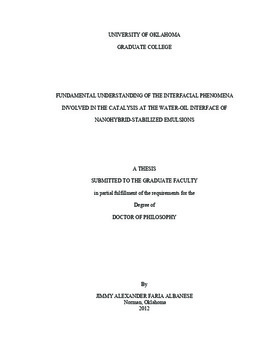| dc.contributor.advisor | Resasco, Daniel E | |
| dc.creator | Faria, Jimmy Alexander | |
| dc.date.accessioned | 2019-06-03T20:35:26Z | |
| dc.date.available | 2019-06-03T20:35:26Z | |
| dc.date.issued | 2012 | |
| dc.identifier | 9917771702042 | |
| dc.identifier.uri | https://hdl.handle.net/11244/320197 | |
| dc.description.abstract | The development of reactive-separation processes in which products are separated from the reaction media (i.e. reactants and catalysts) in a single reaction unit is prized by energy and chemicals industries for its simplicity and novelty. A perfect example of this technology is phase transfer catalysis (PTC), in which reactions are carried out in a biphasic mixture of two immiscible solvents; added surfactants such as quaternary ammonium salts enhance interfacial surface area (through emulsification) and facilitate transfers between the phases. This approach is of interest when valuable products can be separated into the other phase, based on their solubility, preventing undesired secondary reactions (e.g. thermal decomposition). Despite these advantages, the application of this technology in industrial scale results challenging, as the separation of the reaction products from the catalyst or from any reaction solvent is often complex and expensive. In contrast, solid particles are more easily recoverable and have also been shown in many cases to stabilize aqueous-organic emulsions, but these solid-stabilized emulsions have not been widely used in catalytic contexts. | |
| dc.description.abstract | In this contribution, a unique family of catalytic-amphiphilic nanoparticles that catalyze reactions at the liquid-liquid interface of water-oil emulsions is presented. This novel methodology combines the advantages of phase transfer and heterogeneous catalysis: a) increased interfacial area, b) enhanced mass transfer of molecules between the two phases, c) simplified reaction/separation process by using a recoverable solid catalyst instead of surfactant, and d) effective separation of products from the reaction mixture by differences in the water/oil solubility (avoiding heating that leads to product decomposition). | |
| dc.description.abstract | To this end, the present work will explore the application of this technology in biomass conversion to fuels (upgrading of pyrolysis oil and sugars), Fischer-Tropsch synthesis, enhancement of oil recovery. Furthermore, by anchoring the metal catalyst selectively on the hydrophobic or hydrophilic side of the Janus particles it has been demonstrated that it is possible to achieve only conversion of the molecules present in the aqueous or organic phase, i.e. "phase-selectivity". Interestingly, when the hydrophobization of the catalyst was extended to the entire surface the resulting catalyst had an enhanced stability in aqueous environments, while preserving the same emulsification properties. Consequently, hydrophobization of microporous zeolites and metal-oxides catalysts have been successfully employed in the upgrading of bio-fuels in biphasic liquid systems, in which the use of conventional zeolites or metal-oxide catalysts is hindered by fast rates of deactivation due to dissolution into the bulk aqueous phase. | |
| dc.format.extent | 344 pages | |
| dc.format.medium | application.pdf | |
| dc.language | en_US | |
| dc.relation.requires | Adobe Acrobat Reader | |
| dc.subject | Phase-transfer catalysis | |
| dc.subject | Catalysis | |
| dc.subject | Emulsions | |
| dc.subject | Enhanced oil recovery | |
| dc.subject | Biomass conversion | |
| dc.title | FUNDAMENTAL UNDERSTANDING OF THE INTERFACIAL PHENOMENA INVOLVED IN THE CATALYSIS AT THE WATER-OIL INTERFACE OF NANOHYBRID-STABILIZED EMULSIONS | |
| dc.type | text | |
| dc.type | document | |
| dc.thesis.degree | Ph.D. | |
| ou.group | College of Engineering::School of Chemical, Biological and Materials Engineering | |
